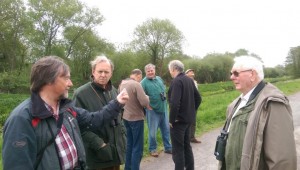
On the Sunday of our reunion of old Old Bristolians we visited the RSPB Ham Wall nature reserve and the Shapwick Heath NNR on the Somerset Levels. We had all been to this area before, 40 years before, looking and listening for Nightjars, Nightingales, Barn Owls and other species on summer evenings. This time we were looking for herons on a spring morning.
Since we previously visited this area it has been mined for peat and then ‘restored’ to a large wetland complex. I was the RSPB’s Head of Conservation Science when the proposal to buy the area now known as Ham Wall came to RSPB Council and there was some scepticism when I promised Council that there would be booming Bitterns at the site within 5 years of reedbed establishment. Five years seemed about right biologically (although it was a bit of a guess) but also for the reason that Council terms of office were for five years so there wouldn’t be too many people remembering that promise when the day of reckoning came around.
I think it took a little more than five years, but not much longer, and there are now 30+ booming Bitterns in this area – I did not imagine, and would not have dared to suggest, that it would be that successful. That’s almost twice as many Bitterns as there were in the whole of the UK when I made the ‘promise’. But there are plenty of them now!
The earliest of us at the site (entirely predictable from our boyhood behaviour) saw Bitterns flying around in pairs above the reedbed and heard them booming away out of site. There were small white egrets, Little Egrets, and quite a few large white egrets, Great (White) Egrets too. The fourth heron species to be seen was a solitary Grey Heron, which would have been the only heron seen on our earlier visits in the mid-1970s.
Little Bitterns have bred here too and I believe Cattle Egrets aren’t that far away. There were masses of Cetti’s Warblers singing – none of us had heard one in the UK back in the 1970s. It’s quite a change. It’s quite a conservation success story. It’s quite a place.
And it’s quite an advert for nature reserves, site protection and habitat recreation too.
The RSPB was confident enough to spend its members’ money on purchase, habitat creation and ongoing management of this site largely because of Bitterns. The RSPB studied Bitterns (shout out for Ken Smith and Glen Tyler!), thought about how to increase their numbers (shout out for Gwyn Williams, Graham Hirons and Gareth Thomas!) and then spent the money and did it (shout out for Council and loads and loads of other people). Like many things that work, it looks very sensible now; back then it looked quite sensible but also quite risky.
This was not the Somerset Levels of our youth. This portion of the Levels is now richer in wildlife than it was then. Other areas are much poorer. It’s a microcosm of the bigger conservation scene – progress on small areas where conservationists have the whip-hand through ownership or other types of power, but a gloomier pattern on the wider countryside where crude economics holds greater sway. If only we had been more successful in the wider countryside – but that doesn’t take away from the successes in the confined countryside of special areas such as these.
Note from Mark: At the moment, comments on this blog aren’t being displayed. I see them – but you don’t. I’m trying to sort this out but it may take a while as I have other things to do, too! Sorry.
[registration_form]
Mark,
Sounds like a good trip to Shapwick and Ham Wall. I first went to the area in 1981 and saw the heathlands species you mentioned plus partridges ( quail in good years) , whinchats and yellow wagtails. So the area has completely changed from wet heathland to wetland. The barn owls are still doing ok though.
I think it took about 16 years from purchase of Ham Wall ( our RSPB group had a visit when the machinery was constructing it) to breeding bitterns but once nesting they multiplied rapidly. You didn’t mention marsh harriers (might be another record year for them) , hobbies ( 50 in one sweep of the sky a week or so ago), bearded tits ( lots but not seen much). Perhaps you could have mentioned the first site manager,Sally Mills who did a great job inba bit of unknown restoration conservation and kept faith when the wintering bitterns cleared off each spring. And the current staff also do a brilliant job – the new car park was a nightmare in planning and construction ( couldn’t do it innthe summer becausevof breeding birds – couldnt do it in the winter because of the wintering birds… They alll deserve our gratitude.